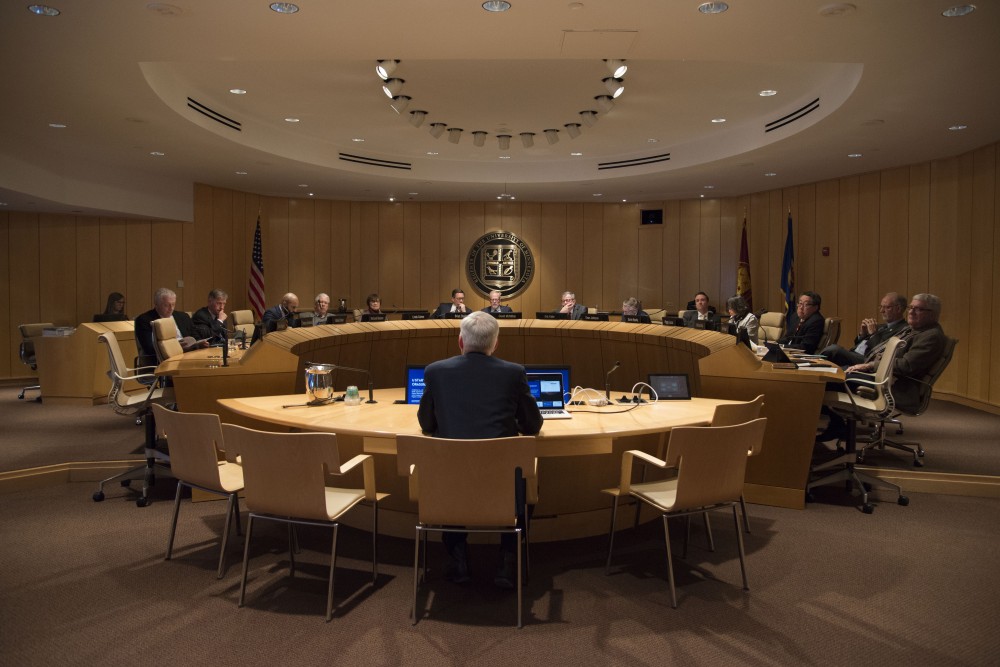The recommended candidates for the Board of Regents are more diverse than ever, a change many say is necessary to better represent the University of Minnesota’s student body.
The regents take a leading role the University’s executive decision-making process, working with administrators on important issues affecting students like tuition and legislative funding. Out of the current 12 regents, only two are female and the vast majority are white.
The board’s make-up does not match that of the University at large. Across the University of Minnesota system, 53.6 percent of students are female and 19.5 percent are people of color.
Seventy-five percent of recommended candidates for the board in this year’s regent elections are women or people of color, according to Regent Candidate Advisory Council, which makes recommendations to the Legislature before lawmakers vote on open regent seats in the spring. One recommended candidate has since dropped out.
This year’s recommendations are among “the most diverse in RCAC history,” according to RCAC’s Recommendation Report.
“Seventy-five percent is a great start,” said Joshua Preston, who is running for the student regent seat. “Is that enough? No, I don’t think so, not until we have the board that accurately reflects the changing face of Minnesota.”
Diversity is lacking on executive boards across higher education. Female representation on boards is about 32 percent, according to a 2016 survey by the Association of Governing Boards of Universities and Colleges.
In 2017, only two out of RCAC’s 12 recommendations for the seats were women.
Because RCAC’s recommendations are not binding, concerns remain about the board lacking diversity.
Board Chair David McMillan declined to comment on behalf of the Board of Regents for this story.
Past considerations during board elections
According to RCAC Chair Dan Wolter, the council looked at diversity when choosing recommended candidates.
“There was a very deliberate effort to make sure we were expanding recruitment opportunities towards communities of color and other groups,” Wolter said. “From our perspective, we want to make sure we’re giving the Legislature diverse options.”
The current recommendations include candidates from various backgrounds, including the first Hmong woman admitted to the Minnesota State Bar, retired government officials and two people who came to the United States as refugees, Wolter said.
In the 2017 regent election cycle, all open seats on the board were filled by white men, resulting in a three-quarters male board. One of the three women on the board at the time, Patricia Simmons, resigned last March, leaving Peggy Lucas and Linda Cohen as the only women on the board. Both of their seats are currently up for election and Cohen is not running for re-election.
Rep. Bud Nornes, R-Fergus Falls, a member of the House higher education committee, said diversity is part of the legislature’s discussions and selection process for future regents.
“In my mind, [the Board has] evolved into being a better balance of people to represent the state of Minnesota over the years. You need balance, and in the end you want the best candidate, but the diversity issue is something that’s very serious in that selection process,” he said.
Around half of current Regents come from executive or CEO backgrounds. The regent position attracts many who have just retired from “bigger” positions, Wolter said.
“If you’re at an entry-level job or in the beginning of your career, it’s probably less easy for you to say ‘I’m going to take off three months to go lobby.’ Age doesn’t really come into factor, but just like any job, it’s experience that is often an indirect reference to age in some cases,” he said.
While this year’s RCAC recommendations are 60 percent women, the Legislature can draw from any of the 47 total applicants to fill the seats.
“In a certain scenario, you could have all men on the Board of Regents,” Wolter said.
Reflecting Minnesota
Without better diversity on the Board, regents may not consider issues that impact a variety of populations, said Sylvia Hurtado, former director of the Higher Education Research Institute at the University of California-Los Angeles.
“Many of the [regents] of color have raised important issues about equity, access and climate that other board members have not,” said Hurtado, who has several publications involving diversity in higher education. “The strong focus on diversity … and thinking how to improve the [campus] climate is not always part of it.”
Preston, a current law student and Morris alumnus, said any pool of regent applicants will be biased toward an elderly population with more prestigious backgrounds.
“You have to think, ‘What is the path that puts someone in that position [to apply].’ It’s a path in which only very recently people like myself, someone who comes from a low-income background, someone who is a person of color … could take,” he said.
Mike Kenyanya, student body president at the University of Minnesota-Duluth and candidate for the student regent seat, said the board’s makeup should reflect the state of Minnesota.
“No matter how much of an advocate I am, I can’t sit on that board and say I represent the women population. It’s important to reflect the people you’re making decisions for,” Kenyanya said.
Now that RCAC has submitted its recommendations for the election, the House and Senate higher education committees will meet later this session to make their own recommendations to the entire Legislature.
Kenyanya said he’s confident the current pool of applicants will help diversify the board.
“I think the University as a land grant school is different than any other university, in that it belongs to more than those enrolled at it and those teaching at it. To any Minnesotan, this is their University and [the board] has to reflect that,” he said.








